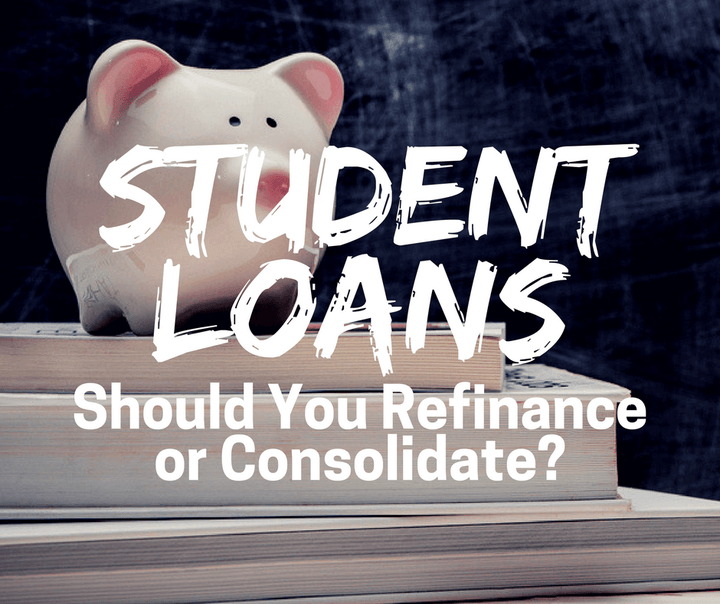
One of the biggest financial challenges that many graduates face is paying back their student loans. Education debts can take over your financial life and make you feel powerless. You want to make smart decisions about your debt, but sometimes the answers just aren’t clear.
Truth is, you have more control over your debt than you may think. So, if you haven’t revisited your student loan repayment strategy, it’s a good time to get familiar with the options.
In this post, I’ll cover the difference between refinancing and consolidating your student loans. You’ll learn how these options make debt more manageable and affordable, which types of loans are eligible, and the best places to shop if either option is right for you. Plus, I’ll answer a question from a podcast listener about how to handle past due student loans.
What Is Student Loan Consolidation?
Understanding consolidation and refinancing can be confusing because the terms are often used interchangeably and for different types of debt, such as credit cards and mortgages. In this post, I'll review how consolidation and refinancing applies to student loans only.
Consolidating means combining multiple student loans into one new loan. The idea is that managing one account with one monthly payment simplifies your financial life. You’re more likely to feel overwhelmed or to inadvertently let a payment due date slip through the cracks if you’re dealing with multiple loans than if you have just one.
But how you can use a consolidation depends on the types of student loans that you have. And you get different results from consolidating federal loans versus consolidating private loans.
True consolidation is only available for loans that originally came from a government program, such as a Direct Loan, Stafford Loan, Perkins Loan, or PLUS loan. The government offers a product called a Direct Consolidation Loan, which allows you to combine most types of federal student loans (but no private loans) into one new, fixed-rate loan.
The upside is that there's no cost to get a Direct Consolidation Loan. But problem is, it generally doesn’t save money because the interest rate is fixed as a weighted average of the rates on the old loans being combined, rounded up to the nearest one-eighth of one percent.
However, consolidating can give you the option to change your repayment schedule. For example, if you have loans with 10-year repayments, you might be able to extend the consolidation term up to a maximum of 30 years.
Stretching out the length of your loan reduces the monthly payments, which can save money in the short-term. But you end up paying more interest over the life of the loan.
Your credit history and current financial situation aren’t factors for getting approved for a federal consolidation, so it’s a great option if you’re having trouble making your monthly payments. Increasing your cash flow also improves your debt-to-income ratio, which makes you more likely to get approved for other credit, such as a student loan refinance, car loan, or mortgage.
If you’re already behind on student loan payments and want to consolidate, you must either catch up by making three consecutive monthly payments first, or agree to repay your new consolidation loan according to one of several income-based repayment plan options.
Consolidation may give you access to additional repayment plan options or forgiveness programs that you didn’t have before. But it may also cause you to lose certain benefits that come with your original loans. Once your loans are paid off and you’re issued a Direct Consolidation Loan, your old loans no longer exist—so be sure to you understand what’s at stake.
Also note that you can only consolidate student loans that are in your name. Education loans taken out by your parents or spouse can’t be combined with your federal student loans.
What Is Student Loan Refinancing?
Now let’s switch gears and cover refinancing. Refinancing is when a new loan with a reduced interest rate is used to pay off one or more existing student loans. It’s available only from private lenders, not the federal government.
So, just to recap, consolidation is only offered from the federal government for multiple federal student loans. And refinancing one or more student loans is only offered by private lenders--they may even allow you to refinance both federal and private loans together.
Unlike with a federal consolidation, a private lender doesn’t offer an interest rate that’s a weighted average of your old rates. They offer rates based on your credit history and finances. If your situation has improved since you took out a private loan or if interest rates have gone down, you’re likely to get a lower rate and save money.
Optimizing your debt by getting a lower interest rate and reduced monthly payments is the major benefit of refinancing. You may even choose a shorter repayment term, which could significantly cut the amount of interest you pay.
But the downside of refinancing a federal loan is that you lose all that benefits that come with it, such as income-based repayment plans and deferment. Depending on your financial situation, that may be less important than getting a lower interest rate.
Should You Refinance or Consolidate Your Student Loans?
Whether you should refinance or consolidate your student loans depends on what you’d like to achieve and how you answer questions like:
- Do I have private or federal student loans?
- Do I qualify to refinance at a lower interest rate?
- Do I believe that I'll need the benefits that come with my federal loans?
If you have federal loans, doing a consolidation isn’t as risky as refinancing them into a private loan. For instance, if you work in public service or any field that allows federal loans to be forgiven after 10 years, you would lose that option with a private lender. Always evaluate the pros and cons carefully before moving a federal loan to a private lender.
If you have private loans, it’s always wise to shop for a lower interest rate. Each lender will evaluate you differently, so use a site like Credible to compare multiple offers. There’s nothing to lose, especially if there are low or no fees charged. Use the Online Loan Comparison Chart to compare lenders for student loans and refinance to a lower interest rate.
If you’re really struggling to pay your federal student loans, consolidation is probably a wise move. But if your finances and credit are in good shape, refinancing federal and private loans for a lower interest rate or shorter term will help you pay them off faster.
To continue reading a student loan Q&A from a Money Girl Podcast listener visit QuickAndDirtyTips.com, where this article was originally published.
Laura Adams is a personal finance expert, award-winning author, and host of the top-rated Money Girl Podcast. Join her online class, Get Out of Debt Fast—A Proven Plan to Stay Debt-Free Forever, to see what’s possible, get a financial fresh start, and connect with others taking their finances to the next level.
